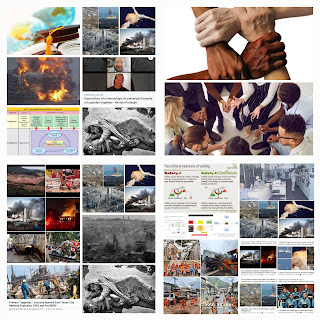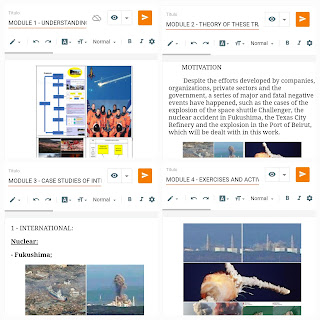To present a dynamic model for Safety
Management, the following model is proposed, shown in Figure 1, as an
adaptation of the boundaries defined by Rasmussen (1997), separating the
activity to be analyzed into three areas:
- Area of Normality – place where the organization
must be positioned; occurrence of non-conformities without criticality for a
major or fatal negative event;
- Danger Area - occurrence of non-conformities that
are critical for a major or fatal negative event, but which have not yet led to
the accident. Area of action of the company's management systems, normality
must be sought, diagnoses must be developed to seek endogenous and exogenous
variables, which may have led to this dangerous area, and through planning,
minimize the possibility of recurrence of these issues:
- Accident Area - apply the emergency and mitigation
plans, to seek a return to the area of normality, as in the diagnosis of
incidents in accidents, the endogenous and exogenous variables that may have
led to the incident must be sought, and through planning to minimize the
possibility of accidents reoccurring.
The model presents us with an arrow with increased
risk, due to social and economic pressures, for profitability, achievement of
goals, granting financial bonuses, increased workload, and others, which
threaten acceptable limits, for safe and good performance of activities,
leading the organization to incidents and accidents.
Figure 1 Proactive Safety Dynamics Model
It is important to understand systemically the
dynamics of safety management.
“Focus on the Dynamics of Proactive Safety and
not on Human Error”.
Second Principle of Proactive Safety.
For more information, videos, and complementary materials, about Safety, access the link at the end of this post.
Are we paying attention to the essential issues for the Safety of Organizations?
How many lives, what social, environmental, patrimonial impact, in the image of the organization and others, would be spared?
It is important to look into these issues, and to deepen academic studies, with application in companies, to develop proposals to avoid these tragedies.
Below is the proposal for the prevention and mitigation of major and fatal negative events, which I developed based on studies and application in organizations.
It is important to present models, principles and structured forms, together with lessons learned from Major and Fatal Negative Events, which facilitate the analysis of these tragedies, That's why I created the Prevent Tragedy Course - Proactive Safety, Risks, and Emergencies Methodology (ProSREM).
I developed ProSREM, in my Ph.D., in progress, in Production Engineering at UFRJ, and used as academic bases: Ergonomics, Resilience Engineering, Integrated Management Systems (Quality, Safety, and Environment), among other methods and tools, and my database to build this proposal, was the biggest and fatal negative events, prominent in the world and in Brazil, I apply this methodology at Fiocruz, where I am a public servant and in organizations, companies, sectors, and activities.
If you are interested in the proposal, send me an email, and when there is the availability of e-learning training, of the Introductory Course of the Proactive Safety Method, Risks and Emergencies, I can contact you, the email is (at the moment, only in Portuguese):
washington.fiocruz@gmail.com
I will send you a form, for your registration, for the e-learning training, or you can access the form, with the initial guidelines at (at the moment, only in Portuguese):
https://drive.google.com/drive/u/2/folders/1A4DBxbZ_cM5mv5j2YxuzqsomyarkSXWI
If you are a professional with experience in the area of safety, risk management, or similar areas, the initial training will consist of two 1-hour meetings, plus guided reading of the modules, complementary materials, and other guidelines, which I will send.
I will assemble these training, in order of registration, so speed up yours, to start the course earlier.
This course will be free of charge and will help me at this stage of my research, for the Doctorate in Production Engineering at UFRJ.
Prevent Tragedy Course - Reports of professionals from the course's study cycle:
- They liked the proposal, it lacks this approach with application in the industry (deficiency in the training), very didactic, motivating for the theme, bringing reality, bringing disasters, it could be avoided, ANDEST (National Association of Teachers in Engineering Safety at Work in Brazil) identified a deficiency in risk management in the training of the safety eng., posts of proactive safety are important, you raise the ball, it is up to people to absorb the lessons of the post, I encourage them to understand what happened, think about all the aspects, awaken this need for analysis.
Access the link to the Proactive Security online course (in Portuguese, but you can translate the Blog pages into your language by clicking on the mouse, on the right side, and translating the page. I'm starting posts in English, and in the future, I'll be offering an e-learning course in English):




Comentários
Postar um comentário